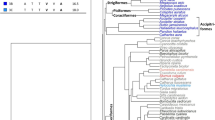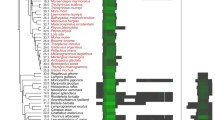Abstract
Dioxin-like compounds are chronically toxic to most vertebrates. However, dramatic differences in sensitivity to these chemicals exist both within and among vertebrate classes. A recent study found that in birds, critical amino acid residues in the aryl hydrocarbon receptor (AhR) ligand binding domain are predictive of sensitivity to dioxin-like compounds in a range of species. It is currently unclear whether similar predictive relationships exist for fishes, a group of animals at risk of exposure to dioxin-like compounds. Effects of dioxin-like compounds are mediated through the AhR in fishes and birds. However, AhR dynamics are more complex among fishes. Fishes possess AhRs that can be grouped within at least three distinct clades (AhR1, AhR2, AhR3) with each clade possibly containing multiple isoforms. AhR2 has been shown to be the active form in most teleosts, with AhR1 not binding dioxin-like compounds. The role of AhR3 in dioxin-like toxicity has not been established to date and this clade is only known to be expressed in some cartilaginous fishes. Furthermore, multiple mechanisms of sensitivity to dioxin-like compounds that are not relevant in birds could exist among fishes. Although, at this time, deficiencies exist for the development of such a predictive relationship for application to fishes, successfully establishing such relationships would offer a substantial improvement in assessment of risks of dioxin-like compounds for this class of vertebrates. Elucidation of such relationships would provide a mechanistic foundation for extrapolation among species to allow the identification of the most sensitive fishes, with the ultimate goal of the prediction of risk posed to endangered species that are not easily studied.

Similar content being viewed by others
References
Abnet CC, Tanguay RL, Hahn ME, Heideman W, Peterson RE (1999) Two forms of aryl hydrocarbon receptor type 2 in rainbow trout (Oncorhynchus mykiss). J Biol Chem 274:15159–15166
Andreasen EA, Spitsbergen JM, Tanguay RL, Stegeman JJ, Heideman W, Peterson RE (2002) Tissue-specific expression of AHR2, ARNT2, and CYP1A in zebrafish embryos and larvae: effects of developmental stage and 2,3,7,8-tetrachlorodibenzo-p-dioxin exposure. Toxicol Sci 68:403–419
Antkiewicz DS, Burns CG, Carney SA, Peterson RE, Heideman W (2005) Heart malformation is an early response to TCDD in embryonic zebrafish. Toxicol Sci 84:368–377
Birnbaum LS, DeVito MJ (1995) Use of toxic equivalency factors for risk assessment for dioxins and related compounds. Toxicol 105:391–401
Doering JA, Wiseman S, Beitel SC, Tendler BJ, Giesy JP, Hecker M (2012) Tissue specificity of aryl hydrocarbon receptor (AhR) mediated responses and relative sensitivity of white sturgeon (Acipenser transmontanus) to an AhR agonist. Aquat Toxicol 114–115:125–133
Elonen GE, Spehar RL, Holcombe GW, Johnson RD, Fernandez JD, Erickson RJ, Tietge JE, Cook PM (1998) Comparative toxicity of 2,3,7,8-tetrachlorodibenzo-p-dioxin to seven freshwater fish species during early life-stage development. Enviro Toxico Chem 17:472–483
Evans BR, Karchner SI, Franks DG, Hahn ME (2005) Duplicate aryl hydrocarbon receptor repressor genes (ahrr1 and ahrr2) in the zebrafish Danio rerio: structure, function, evolution, and AHR-dependent regulation in vivo. Arch Biochem Biophys 441:151–167
Evans BR, Karchner SI, Allan LL, Pollenz RS, Tanguay RL, Jenny MJ, Sherr DH, Hahn ME (2008) Repression of aryl hydrocarbon receptor (AHR) signalling by AHR repressor: role of DNA binding and competition for AHR nuclear translocator. Mol Pharmacol 73:387–398
Fleming CR, Billiard SM, Di Giulio RT (2009) Hypoxia inhibits induction of aryl hydrocarbon receptor activity in topminnow hepatocarcinoma cells in an ARNT-dependent manner. Comp Biochem Physiol C Toxicol Pharmacol 150:383–389
Gabos S, Ikonomou MG, Schopflocher D, Fowler BR, White J, Prepas E, Prince D, Chen W (2001) Characteristics of PAHs, PCDD/Fs and PCBs in sediment following forest fires in northern Alberta. Chemo 43:709–719
Hahn ME (2001) Dioxin toxicology and the aryl hydrocarbon receptor: insights from fish and other non-traditional models. Mar Biotechnol 3:224–238
Hahn ME (2002) Aryl hydrocarbon receptors: diversity and evolution. Chemico-Biol Interact 141:131–160
Hansson MC, Hahn ME (2008) Functional properties of the four Atlantic salmon (Salmo salar) aryl hydrocarbon receptor type 2 (AHR2) isoforms. Aquat Toxicol 86:121–130
Head JA, Kennedy SW (2010) Correlation between an in vitro and an in vivo measure of dioxin sensitivity in birds. Ecotoxicol 19:377–382
Head JA, Hahn ME, Kennedy SW (2008) Key amino acids in the aryl hydrocarbon receptor predict dioxin sensitivity in avian species. Environ Sci Technol 42:7535–7541
Hilscherova K, Kannan K, Nakata H, Hanari N, Yamashita N, Bradley PW, McCabe JM, Taylor AB, Giesy JP (2003) Polychlorinated dibenzo-p-dioxin and dibenzofuran concentration profiles in sediments and flood-plain soils of the Tittabawassee River. Michigan Environ Sci Technol 37:468–474
Jenny MJ, Karchner SI, Franks DG, Woodlin BR, Stegeman JJ, Hahn ME (2009) Distinct roles of two zebrafish AHR repressors (AHRRa and AHRRb) in embryonic development and regulating the response of 2,3,7,8-tetrachlorodibenzo-p-dioxin. Toxicol Sci 110:426–441
Johnson RD, Tietge JE, Jensen KM, Fernandez JD, Linnum AL, Lothenbach DB, Holcombe GW, Cook PM, Christ SA, Lattier DL, Gordon DA (1998) Toxicity of 2,3,7,8-tetrachlorodibenzo-p-dioxin to early life stage brooke trout (Salvelinus fontinalis) following parental dietary exposure. Enviro Toxicol Chem 17(12) 2408–2421
Karchner SI, Franks DG, Hahn ME (2005) AHR1B, a new functional aryl hydrocarbon receptor in zebrafish: tandem arrangement of ahr1b and ahr2 genes. Biochem J 392(Pt 1):153–161
Karchner SI, Franks DG, Kennedy SW, Hahn ME (2006) The molecular basis for differential dioxin sensitivity in birds: role of the aryl hydrocarbon receptor. Proc Natl Acad Sci U S A 103:6252–6257
Kawajiri K, Fujii-Kuriyama Y (2007) Cytochrome P450 gene regulation and physiological functions mediated by the aryl hydrocarbon receptor. Arch Biochem Biophy 464:207–212
Le Comber SC, Smith C (2004) Polyploidy in fishes: patterns and processes. Biol J Linn Soc 82:431–442
Marvin C, Alaee M, Painter S, Charlton M, Kauss P, Kolic T, MacPherson K, Takeuchi D, Reiner E (2002) Persistent organic pollutants in Detroit River suspended sediments: polychlorinated dibenzo-p-dioxins and dibenzofurans, dioxin-like polychlorinated biphenyls and polychlorinated naphthalenes. Chemo 49:111–120
Naile JE, Khim JS, Wang T, Wan Y, Luo W, Hu W, Jiao W, Park J, Ryu J, Hong S, Jones PD, Lu Y, Giesy JP (2011) Sources and distribution of polychlorinated-dibenzo-p-dioxins and –dibenzofurans in soil and sediment from the Yellow Sea region of China and Korea. Enviro Pollut 159:907–917
Nelson JS (1994) Fishes of the world, 3rd edn. John Wiley, Sons, Inc, New York
Okey AB (2007) An aryl hydrocarbon receptor odyssey to the shores of toxicology: the Deichmann Lecture, International Congress of Toxicology-XI. Toxicol Sci 98:5–38
Prasch AL, Tanguay RL, Mehta V, Heideman W, Peterson RE (2006) Identification of zebrafish ARNT1 homologs: 2,3,7,8-tetrachlorodibenzo-p-dioxin toxicity in the developing zebrafish requires ARNT1. Mol Pharmacol 69:776–787
Tanguay RL, Abnett CC, Heideman W, Peterson RE (1999) Cloning and characterization of the zebrafish (Danio rerio) aryl hydrocarbon receptor. Biochem Biophys Acta 1444:35–48
Toomey BH, Bello S, Hahn ME, Cantrell S, Wright P, Tillitt D, DiGiulio RT (2001) TCDD induces apoptotic cell death and cytochrome P4501A expression in developing Fundulus heteroclitus embryos. Aquat Toxicol 53:127–138
Van den Berg M, Birnbaum L, Bosveld ATC, Brunstrom B, Cook P, Feeley M, Giesy JP, Hanberg A, Hasegawa R, Kennedy SW, Kubiak T, Larsen JC, van Leeuwen RXR, Liem AKD, Nolt C, Peterson RE, Poellinger L, Safe S, Schrenk D, Tillitt D, Tysklind M, Younes M, Waern F, Zacharewski T (1998) Toxic equivalency factors (TEFs) for PCBs, PCDDs, PCDFs for human and wildlife. Enviro Hlth Persp 106:775–792
Wade TL, Sweet ST, Klein AG (2008) Assessment of sediment contamination in Casco Bay, Maine. USA Environ Pollut 152:505–521
Walker MK, Spitsbergen JM, Olson JR, Peterson RE (1991) 2,3,7,8-Tetrachlorodibenzo-para-dioxin (TCDD) toxicity during early life stage development of lake trout (Salvelinus namaycush). Canad J Fisheries Aqua Sci 48:875–883
Wang L, Liang X, Zhang W, Mai K, Huang Y, Shen D (2009) Amnesic shellfish poisoning toxin stimulates the transcription of CYP1A possibly throught AhR and ARNT in the liver of red sea bream Pagrus major. Mar Pollut Bull 58:1643–1648
Whyte JJ, Jung RE, Schmitt CJ, Tillitt DE (2000) Ethoxyresorufin-O-deethylase (EROD) activity in fish as a biomarker of chemical exposure. Crit Rev Toxicol 30:347–570
Wirgin I, Roy NK, Loftus M, Chambers RC, Franks DG, Hahn ME (2011) Mechanistic basis of resistance to PCBs in Atlantic tomcod from the Hudson River. Science 331:1322–1324
Wiseman SB, Vijayan MM (2007) Aryl hydrocarbon receptor signaling in rainbow trout hepatocytes: role of hsp90 and the proteasome. Comp Biochem Physiol C Toxicol Pharmacol 146:484–491
Yamauchi M, Kim EY, Iwata H, Tanabe S (2005) Molecular characterization of the aryl hydrocarbon receptors (AHR1 and AHR2) from red seabream (Pragrus major). Comp Biochem Physiol C 141:177–187
Yamauchi M, Kim EY, Iwata H, Shima Y, Tanabe S (2006) Toxic effects of 2,3,7,8-tetrachlorodibenzo-p-dioxin (TCDD) in developing red seabream (Pagrus major) embryos: an association of morphological deformities with AHR1, AHR2 and CYP1A expressions. Aquat Toxicol 16:166–179
Zabel EW, Cook PM, Peterson RE (1995) Toxic equivalency factors of polychlorinated dibenzo-p-dioxin, dibenzofuran and biphenyl congeners based on early-life stage mortality in rainbow trout (Oncorhynchus mykiss). Aquat Toxicol 31:315–328
Acknowledgments
J. Doering was supported through the NSERC CREATE program in Human and Ecological Risk Assessment, the University of Saskatchewan Dean's Scholarship, and the Saskatchewan Innovation and Opportunity Scholarship. M. Hecker was supported through the Canada Research Chair program. J. Giesy was supported through the Canada Research Chair program, an at-large chair professorship at the Department of Biology and Chemistry and State Key Laboratory in Marine Pollution, City University of Hong Kong, and The Einstein Professor Program of the Chinese Academy of Sciences.
Author information
Authors and Affiliations
Corresponding author
Additional information
Responsible editor: Philippe Garrigues
Rights and permissions
About this article
Cite this article
Doering, J.A., Giesy, J.P., Wiseman, S. et al. Predicting the sensitivity of fishes to dioxin-like compounds: possible role of the aryl hydrocarbon receptor (AhR) ligand binding domain. Environ Sci Pollut Res 20, 1219–1224 (2013). https://doi.org/10.1007/s11356-012-1203-7
Received:
Accepted:
Published:
Issue Date:
DOI: https://doi.org/10.1007/s11356-012-1203-7




